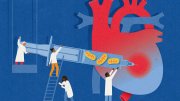Introductory biology students often hear that mitochondria are “the powerhouses of the cell.” These bean-shaped microscopic organelles produce cellular energy. But a new field of research suggests that mitochondria are much more than that.
James Donald McCully, an associate professor of surgery at Harvard Medical School, has pioneered the use of these tiny organelles to treat newborns with damaged hearts. Sometimes, when newborns undergo heart surgery, the blood flow to their hearts temporarily stops—a condition called “ischemia,” which can set off a cascade of issues. Without oxygen, mitochondria cannot produce energy. Without energy, cells die, and muscle becomes useless scar tissue; infants with this complication have a one-in-ten survival rate.
McCully believes the answer to this problem—and many other biomedical quandaries—lies in mitochondria. For nearly two decades, his lab has been perfecting the process of “mitochondrial transplants”—isolating mitochondria from healthy abdominal muscle tissue, then injecting them directly into malfunctioning hearts.
During the past decade, McCully has performed mitochondrial transplants on 17 infants who suffered ischemic events during heart surgery; 13 of them survived. New research shows that mitochondrial transplants can help heal other organs, too.
When McCully, a cardiac surgeon, started studying mitochondria in 2007, few scientists were assessing mitochondria’s potential to save damaged cells. One breakthrough came almost by accident, with a pig he was studying in his lab. As McCully’s team was pulling mitochondria from a tissue sample, the animal went into atrial fibrillation—a condition in which a rapid heartbeat slows blood flow. McCully grabbed some of the mitochondria he had just isolated, injected them into the pig’s heart, and saw that the heart function visibly improved.
During the past 18 years, McCully has refined the mitochondrial transplantation process and expanded its use to humans. Whereas early isolations of these organelles took at least 90 minutes, now he can derive pure mitochondria from a tissue sample the size of an eraser within 20 minutes, never leaving the patient’s bedside.
Scientists are not yet certain why mitochondrial transplants work, but McCully has a rough understanding. Upon injection into a tissue or a nearby artery, the organelles quickly enter cells, fuse with other mitochondria close to the nucleus, and begin sending out signals ordering the cell to stop destroying itself and to restore normal function.
This restorative property means that surgeons may one day be able to perform mitochondrial transplants before operations begin, McCully says, preventing tissue death during long procedures. “We’ll spend the next 15 or 20 years trying to figure out the minutiae,” he says, “but it works.”
Some researchers, McCully says, are now investigating how mitochondrial transplants could be used to treat spine and brain injuries, including for diseases such as Alzheimer’s and Parkinson’s. With funds from a philanthropic foundation, McCully’s own lab is investigating whether those transplants could help patients with metabolic diseases caused by mitochondrial dysfunction, which has been implicated in neurodegenerative disorders, diabetes, cancer, altered immune response, and even aging.
While studying at Harvard, Fernando Rubio-Mijangos, M.A. ’25, conducted research in McCully’s lab on whether mitochondrial transplants could work in the eyes, healing retinas after a period of blood loss. For his master’s thesis, Rubio-Mijangos performed mitochondrial transplants on cell samples that mimicked damaged retina cells. He found that the organelles prevented cell death, minimized immune overreaction, and reduced the effects of stress-response genes associated with inflammation.
Watching mitochondria strengthen these beleaguered cells led Rubio-Mijangos to reassess his understanding of how cells work. Within the cell, he says, “We always thought the nucleus was the brain, but I think it’s the mitochondria.”
Rather than calling mitochondria the “powerhouse,” Rubio-Mijangos suggests a new moniker: “the guardian of the cell.”








